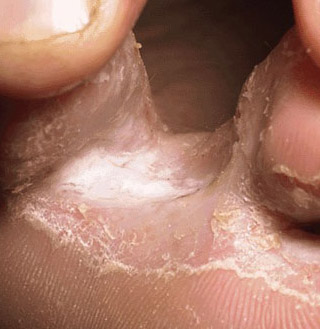athlete's foot
Athlete's foot or tinea pedis is a fungal infection of the skin of the foot, usually between the toes, caused by parasitic fungi. Growth of the athlete's foot fungus is promoted by a dark, warm, moist environment such as that found inside shoes. The fungi persist for a long time in the environment, facilitating transmission of the disease in communal areas such as locker rooms and showers. Athlete's foot causes scaling, flaking and itching of the affected skin. Blisters and cracked skin may also occur, leading to exposed raw tissue, pain, swelling, and inflammation. The infection can be spread to other areas of the body, such as the armpits, knees, elbows, and the groin, and usually is called by a different name once it spreads (such as jock itch or tinea cruris for an infection of the skin of the groin).
causes
Athlete's foot is a layman's description of a skin fungal infection. Fungal infections of the skin are called dermatophytosis. Dermatophytes may be spread from other humans (anthropophilic), animals (zoophilic) or may come from the soil (geophilic). Anthropophillic dermatophytes are restricted to human hosts and produce a mild, chronic inflammation. Zoophilic organisms are found primarily in animals and cause marked inflammatory reactions in humans who have contact with infected cats, dogs, cattle, horses, birds, or other animals. Geophilic species are usually recovered from the soil but occasionally infect humans and animals. They cause a marked inflammatory reaction, which limits the spread of the infection and may lead to a spontaneous cure but may also leave scars. Infections or infestations occur when dermatophytes grow and multiply in the skin.
treatment
The infected area is often treated with topical antifungal agents such as miconazole, itraconazole, terbinafine and a keratolytic such as salicylic acid. Topical agents only clear the infection about 30% of the time and provide mycologic cures (absence of organisms) less than 15% of the time. The time line for cure may be long, often 45 days or longer. However, because the itching associated with the infection subsides quickly, patients may not complete the courses of therapy prescribed. Washing socks, underwear and bed clothes at 60C or 140F will also help prevent any reinfection.
If the fungal invader is not a dermatophyte but a yeast, other medications such as fluconazole may be used. Typically diflucan is used for candidal vaginal infections moniliasis but has been shown to be of benefit for those with cutaneous yeast infections as well. The most common of these infections occur in the web spaces (intertriginous) and at the base of the fingernail or toenail. The hall mark of these infections is a cherry red color surrounding the lesion and a yellow thick pus.
Traditional remedies for athlete's foot include tea tree oil or crocodile oil in a topical application on the affected area. Users report instant relief from itching allowing lesions to heal. Proponents of urine therapy claim that urine is very effective at killing athlete's foot. Urea, the "active ingredient" in urine, is already used in many drugs and treatments made by pharmaceutical companies to treat athlete's foot. This controversial treatment method recommends urinating on the infected area once a day in the shower. According to supporters, urine therapy not only kills existing fungi, it prevents new fungi from growing in the infected area.
more information
The Family Doctor (Tinea Infections)American Podiatric Medical Association
BC Health Guide (Athlete's Foot)


